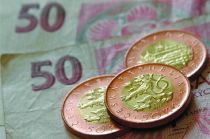Show Me the Money
 Currency's symbolic qualities often begin to pale when you use it everyday since it becomes a mere trade object. American money has, for me, lost some its fascination (at least symbolically, though not financially).
Currency's symbolic qualities often begin to pale when you use it everyday since it becomes a mere trade object. American money has, for me, lost some its fascination (at least symbolically, though not financially).Yet Czech coins are still relatively new to me. Not having grown up with them, they still hold curious symbols of the state somewhat revelatory in how they show Czech culture. They also reveal centers of political and economic power, or at least indicate things that the designers have been commissioned to communicate. The obverse of Czech coins features the double-tailed lion of Bohemia and the words "Czech Republic" (in Czech of course).
The reverses show various recognizable symbols of famous Czech things, heroes, or places. So, the 5-crown coin has an abstract set of shapes that is vaguely reminiscent of the Charles Bridge over the Vltava in Prague.
 The 20-crown coin shows St. Wenceslas on a horse; it is, in fact, a representation of the statue at the top of Wenceslas Square in Prague. The 50-crown coin features Prague and its symbols: the Charles Bridge (again), the St. Nicholas Church, the Little Royal Summer Palace (oddly appearing next to the Charles Bridge), the Prague Castle, and the St. Vitus Cathedral. It also sports the Latin slogan, Praga mater urbium (Prague, mother of cities).
The 20-crown coin shows St. Wenceslas on a horse; it is, in fact, a representation of the statue at the top of Wenceslas Square in Prague. The 50-crown coin features Prague and its symbols: the Charles Bridge (again), the St. Nicholas Church, the Little Royal Summer Palace (oddly appearing next to the Charles Bridge), the Prague Castle, and the St. Vitus Cathedral. It also sports the Latin slogan, Praga mater urbium (Prague, mother of cities).Detecting a theme yet? Well, um . . . wait a moment . . . hmm . . . why yes! It seems that so far every one of the coins has a connection with Bohemia and Prague. What about Moravia? What about Silesia? Brno? Olomouc? Ostrava? They all seem to be missing. Hmm. But wait, there's still the 10-crown coin. That has Brno on the back!
 Well, the Sts. Peter and Paul Cathedral at least. The 2-crown coin has a Great Moravian talisman of sorts (a gombik). That's from back in the ninth century, when the Moravians ruled the Czechs. So there is a bit of Moravian representation.
Well, the Sts. Peter and Paul Cathedral at least. The 2-crown coin has a Great Moravian talisman of sorts (a gombik). That's from back in the ninth century, when the Moravians ruled the Czechs. So there is a bit of Moravian representation.We know where the center of Europe is. Unquestionably! And now it seems that the center of power has also been identified. (Well, I know we're only talking the Czech Republic here, but come on: that's the heart of Central Europe so it must count for more.*) Of the Czech coin-types in circulation, this means that only about 30% have any reference to areas that make up over 50% of the country. Area-wise, this represents even less than half since Prague covers only a small fraction of Bohemia. Perfectly balanced, wouldn't you say?
Tags: Czech, coins, Pragocentrism
 A graduate student in music and anthropology writing a dissertation about music in Moravia, the eastern third of the Czech Republic. At some point, the Czech Republic's "second city" (that would be Brno) captured my attention, and I've since been blogging about events, arts, music, and other stuff—basically whatever interests me in and around the cityscape. I'm not living in Brno now, but I keep up with the cultural pulse from afar as best I can.
A graduate student in music and anthropology writing a dissertation about music in Moravia, the eastern third of the Czech Republic. At some point, the Czech Republic's "second city" (that would be Brno) captured my attention, and I've since been blogging about events, arts, music, and other stuff—basically whatever interests me in and around the cityscape. I'm not living in Brno now, but I keep up with the cultural pulse from afar as best I can.


Comments:
Pragocentrism strikes again!
As for the coins, while the 50 is an attractive piece, I have enough trouble telling the 10 and 20 apart in my wallet without having to deal with another thing of pretty much the same color and size. I am sick of peering into my wallet trying to see what's a 10 or a 20, a 50-heller or a crown, one crown or two, etc. At least I can usually distinguish the 20 as being somewhat brighter than the 10...
12:34 AM, June 16, 2006
» Post a Comment